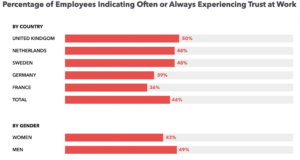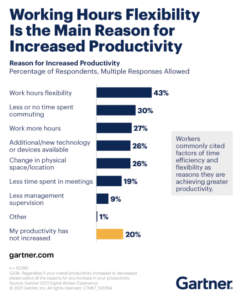
The modern workplace may have undergone rapid transformation over the past two years, but one thing hasn’t changed: employees still want to feel trusted and valued by their employers.
For organisations, the goal is simple: build trust in teams and empower them to do their best work. This, however, might as well be capturing lightning in a bottle.
In Europe, for example, less than half (46%) of employees report feeling trusted in the workplace, according to research by nonprofit Catalyst. Women (43%) are also less likely to report experiencing trust at work.

Source: Catalyst
But what exactly makes trust in the workplace so important? And what can employers do to improve or start building trust in teams?
Why building trust in teams is critical to success
If there’s one thing most workers will agree on, they hate bosses that micromanage them. True enough, micromanaging is among the top four most frustrating things bosses do, according to a 2018 LinkedIn survey.
Ultimately, micromanaging at work is a (lack of) trust issue — it’s bosses not trusting the people working for them, hence the desire for more control. But as counterintuitive as it sounds, giving workers more autonomy is key to helping them do their best work. It’s why the demand for flexible working is so high; one study found that 62% of workers in flexible working arrangements feel more trusted to do their jobs more effectively.
Here’s a closer look at the key benefits of building trust in your teams.
Building trust in the workplace — Employee benefits
For starters, employees who feel trusted at work are more likely to report higher levels of job satisfaction.
A PayScale report shows that 72% of employees whose managers trusted them are satisfied at work. This satisfaction decreases alongside declining manager trust — only 26% of workers who report being unable to do anything without being told said they were similarly happy.
Other employee benefits of engendering trust in the workplace include:
- Improved innovation: Trusting employees to solve problems drives new ideas, processes, products and services.
- Improved engagement: Employees who feel their bosses trust them are more likely to take pride in their work and invest in the company’s mission and values.
Building trust in the workplace — Employer benefits
If improving diversity and inclusion is one of your company’s top environmental, social and corporate governance (ESG) goals, you’ll be happy to know that trust is one of five key factors driving inclusion in the workplace, according to research by Catalyst. These factors are:
- Trusted: Workers can make meaningful contributions and influence decisions
- Valued: Workers are appreciated for their skills and perspectives
- Authentic: Workers can bring their full selves to work
- Psychological Safety – Latitude: Workers feel free to hold different viewpoints and make mistakes without retribution
- Psychological Safety – Risk-taking: Workers feel secure enough to take risks
Related Reading: Are You Creating Psychological Safety in the Workplace?
Other employer benefits of building trust in the workplace include:
- Improved company culture: Trusting employees makes it easier for them to buy into your corporate mission and values. When they feel part of something real, teams are more likely to go beyond what’s typically expected of them.
- Improved productivity: Trusting employees to choose how, when and where to work drives increased productivity. A 2021 Gartner survey shows that 43% of workers attributed their increased productivity to flexible working hours.
Source: Gartner
How to build trust in the workplace — 5 ways to get started
1. Be transparent
Transparency is key to building trust in teams. Employees need to know what’s going on in the company, both good and bad.
Yes, certain things will always be confidential and known to leadership, But being more open about decision-making, changes, transitions and challenges promotes a sense of trust and belongingness. This will help your teams feel like they’re part of something bigger than themselves and that their opinions matter.
2. Communicate often and effectively
Communication is essential to any relationship — especially in the workplace. Make sure you’re actively engaging your people through regular check-ins. More importantly, you want to genuinely listen to them; far too many people forget that communication is a mutual or two-way process.
This brings us to the next point.
3. Create and implement feedback mechanisms
Employees are unlikely to trust you (or your efforts to get them to trust the organisation) if they don’t have a way of sharing feedback with your leaders.
The problem, however, is that many companies don’t get it right. In fact, a Gallup poll found that only 26% of workers “strongly agree” that the feedback they receive helps them to be better at work.
This is where cognitive psychologist LeeAnn Renninger‘s research comes in. She and her team of researchers developed a scientifically-tested four-step model for providing and soliciting feedback:
- The Micro-Yes: A short question that signals the start of feedback
- Data Point: Naming what you saw or heard with as much objectivity as possible
- Impact Statement: Identifying the impact of the data point
- An Ending Question: Soliciting feedback from the receiver of feedback.
More importantly, employers must hold themselves accountable for acting on critical feedback. This tells your people that their ideas, suggestions and complaints can and will drive change.
4. Recognise and appreciate good work
Showing employees recognition and appreciation seems like common sense, but not all companies do a good job at it. It’s why 79% of employees who quit their jobs attribute it to not being appreciated at work.
Sure, your employees are paid in exchange for their work, but that’s not enough to demonstrate that you trust and value them. Simple gestures such as sending thank you messages, praising good work, and offering tangible rewards help build a sense of community and address the emotional fulfilment people need.
5. Create a culture of workplace coaching
Coaching is the process of improving your workers’ effectiveness, honing their strengths, and addressing their weaknesses. It’s about teaching workers how to do their best work rather than outright telling them what to do.
This distinction is important because coaching involves trusting people to make the best of any tools, resources and direction you provide. Not only is coaching the right thing to do, but it’s also the more business-savvy approach to management. According to a study in The Manchester Review, organisations that invest in leadership coaching generate nearly $100,000 — an ROI of 5.7x the initial investment.
Related Reading: 3 Examples of Effective Coaching in the Workplace
Trust your employees to earn their trust in return
Trust is essential to any relationship, including the relationship between employer and employee. When employees feel trusted by their employers, they’re more likely to feel motivated and empowered to do their best work. And as the modern workplace undergoes rapid transformation, employers must create a cohesive and engaged community of workers, regardless of their physical location.
Discover more insights about trust in the workplace and employee engagement by reading our other guides in the Cloudbooking blog. If you’re looking for a cloud-based solution to facilitate open communication and collaborative work in your hybrid offices, let Cloudbooking help. Our workplace management platform is the ideal solution for supporting new ways of working, whether it’s agile, activity-based working or hybrid working. Get in touch with our team to schedule an obligation-free demo.



